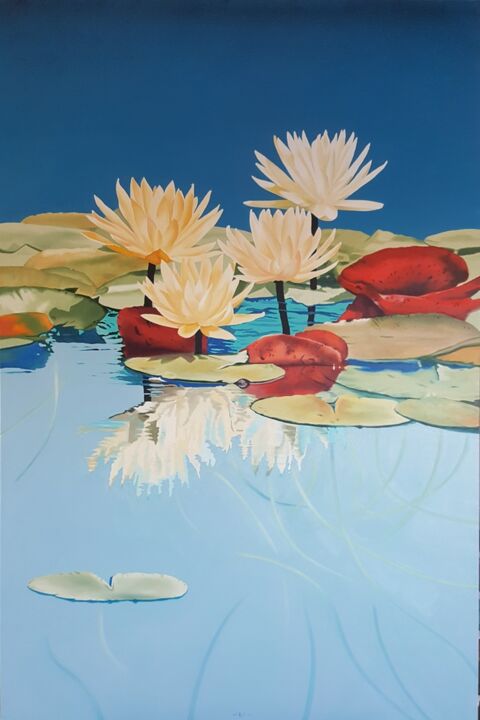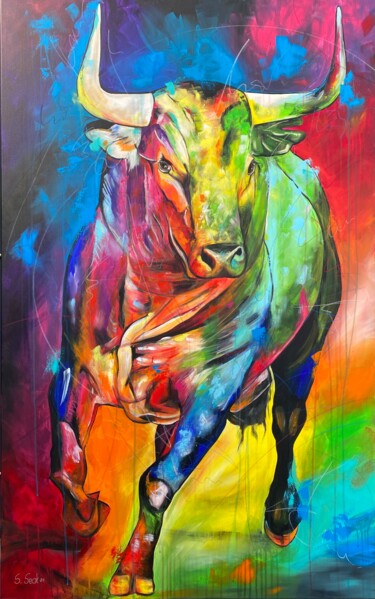Art as "eternal remake"
The selection shows exclusively some works of art, including paintings and sculptures, distinguished by their large format, which are part of the collection of Artmajeur. All these works, despite their strong originality and independence, are united by a deep connection with the most famous artistic currents, or the masterpieces of the great masters, who have indelibly marked the history of Western art. Owning a painting inspired by the great artistic tradition, means knowing and appreciating our past, but also giving a value to contemporary works, which are the result, more or less unconscious, of a strong and immortal cultural heritage. In fact, it is good to emphasize that, art, even the most innovative, has always looked to the past, even if only with the aim of detaching itself abruptly from it. For this reason, the link between the classics of art and contemporary works, although sometimes unconscious and unwanted, is fundamentally inevitable as it is impossible to create in the absence of reference points.
Keith Haring, Tuttomondo, 1989. Mural, 1000 × 1800 cm. Pisa: Church of Sant'Antonio Abate.
 Vincent Bardou, Graffiti Pop, 2021. Acrylic on canvas, 100 x 200 cm.
Vincent Bardou, Graffiti Pop, 2021. Acrylic on canvas, 100 x 200 cm.
Vincent Bardou: Graffiti Pop
The artwork of the artist of Artmajeur, Bardou, combines, as per the title, the distinctive features of two different artistic currents, which have marked the figurative tradition of the second half of the twentieth century, such as graffiti and Pop art. Regarding the first movement, it, born in America at the end of the sixties, wanted to give voice to the anger of the urban underclass, who lived in conditions of total social and racial marginalization. In fact, the language of graffiti, characterized by the strong expressiveness and immediacy of the bright colors of spray cans, used as a support the old walls of houses, abandoned buildings and dingy underpasses of the suburban city. In the 1980s, the art world began to take an interest in this movement, which, having become commercial, found its most important ambassadors in the figures of Keith Haring and Jean Michel Basquiat. As for Bardou's painting, it depicts the multiplication and overlapping of tags and graffiti, which are arranged over the entire surface of the canvas. This "serial production" of brightly colored lettering transforms the underground subject into a pop refrain. It is precisely the juxtaposition of these two artistic currents, with their completely opposite ideology, that makes Bardou's work an innovative and unique piece of art.
Joan Mitchell, exponent of abstract expressionism, inside her studio in Vértheuil, France (1983).
 Peter Nottrott, Yellow Energy waves XXL 1, 2021. Acrylic on canvas, 100 x 200 cm.
Peter Nottrott, Yellow Energy waves XXL 1, 2021. Acrylic on canvas, 100 x 200 cm.
Peter Nottrott: Yellow Energy waves XXL 1
The work of Nottrott, artist of Artmajeur, is characterized by an ochre background, on which stand out extensive patches of color, which, composed of different shades, have a slightly fluctuating trend. This simple interpretation, however, could also be enriched by a deeper analysis of the painting, in order to find a real subject or meaning in it. In reality, Nottrott simply wanted to share his personal vision which, being profoundly artistic, is inexorably detached from the mere description of the ordinary visual experience. In fact, the very colors and brushstrokes become the spokesperson for totally innovative messages and concepts that escape the monotony and repetition of the real world. In addition, even if the image has become unrecognizable, it has acquired the ability to let us know, through the evocative power of the colors, the feelings that the artist felt at the time of the conception of the work. Finally, it is clear that all of these characteristics allow us to place Nottrott's painting within the artistic current of abstractionism, the first movement to declare that the relationship between art and reality had ceased.
 Giovanni Boldini, The Marchesa Luisa Casati with a greyhound, 1908. Oil on canvas. Private collection.
Giovanni Boldini, The Marchesa Luisa Casati with a greyhound, 1908. Oil on canvas. Private collection.
 Cynthia Pedrosa, Enfermé Dehors, 2021. Oil on canvas, 120 x 150 cm.
Cynthia Pedrosa, Enfermé Dehors, 2021. Oil on canvas, 120 x 150 cm.
Cynthia Pedrosa: Enfermé Dehors
The work of the artist from Artmjeur, Pedrosa, re-proposes, in a very personal and original way, a "cult" subject of the history of art, that is the dog, which since ancient times, such as in the works of ancient Egypt and the Romans, has often been immortalized. Subsequently, and more precisely in the period from the Middle Ages to the twentieth century, this animal has been the protagonist, often together with his master, of many famous paintings, such as: Mr. and Mrs. Arnolfini by Jan Van Eyck, the Two Venetian ladies by Vittore Carpaccio, the Portrait of Charles V with dog by Titian, the Two hunting dogs by Jacopo Bassano, the Combat between dogs and wolves by Frans Snyders, The faithful friend by Federico Zandomeneghi, the Dynamism of a dog on a leash by Giacomo Balla, the Two acrobats with dog by Pablo Picasso and the Self-portrait with dog by Antonio Ligabue. Pedrosa's canvas, however, depicts greyhounds, a breed that has had particular fortune within the Western figurative tradition, in particular, for example, in the work of the Italian painter Giovanni Boldini. The latter depicted this subject in masterpieces such as Page playing with a greyhound and Lady with a black greyhound, where, unlike the painting by the artist from Artmajeur, the bond of affection between dog and owner emerges strongly. In fact, the innovativeness and the peculiarity of Pedrosa's work lies precisely in its theme, aimed at showing the loneliness, isolation and confinement in which the aforementioned animals live. This is narrated through a painting of a clearly expressionist nature, which, like the greatest masterpieces belonging to this genre, aims to capture the reality in which we live, photographing its drama, difficulties and contradictions.
 Claude Monet, Water Lilies, 1914-1917. Oil on canvas. Toledo: Toledo Museum of Art.
Claude Monet, Water Lilies, 1914-1917. Oil on canvas. Toledo: Toledo Museum of Art.
 Luigi Maria De Rubeis, Water Lilies, 2021. Acrylic oil and tempera on canvas, 150 x 100 cm.
Luigi Maria De Rubeis, Water Lilies, 2021. Acrylic oil and tempera on canvas, 150 x 100 cm.
Luigi Maria De Rubeis: Water Lilies
The canvas of the artist of Artmajuer, Luigi Maria De Rubeis, proposes a subject that has indelibly marked the artistic research of one of the most important masters of the history of art of all time, Claude Monet. In fact, just the theme of flowers floating on the water, the French artist worked doggedly during the nineties of the nineteenth century, but also later, or in the early decades of the twentieth century. During this long period, the water lilies became for Monet a real obsession, constituting an inexhaustible source of inspiration, which had to be immortalized in the most varied luminous and chromatic effects. The work of the artist from Artmajeur, who reproposes this subject in a very personal way, was able to give a touch of contemporaneity and novelty to a topic now widely exploited. In fact, De Ruben has totally abandoned the Impressionist style, he has diminished his interest in reflections, light and water movements, concentrating on more circumscribed and static water lilies, which have been executed so finely as to seem too perfect to be real.
 Pythocritus of Rhodes, Winged Victory of Samothrace, circa 2nd century BC. Parian marble, 245 cm (height). Paris: Louvre Museum.
Pythocritus of Rhodes, Winged Victory of Samothrace, circa 2nd century BC. Parian marble, 245 cm (height). Paris: Louvre Museum.
 Jean-Yves Verne, Femme Rouge , 2019. Resina, 120 x 70 x 55 cm.
Jean-Yves Verne, Femme Rouge , 2019. Resina, 120 x 70 x 55 cm.
Jean-Yves Verne: Femme Rouge
This sculpture by Artmajuer artist Jean-Yves Verne fits into the most célèbre figurative tradition because, with a little imagination, it can represent a contemporary remake of the Winged Victory of Samothrace, where the wings have been transformed into the sleeves of an elegant red dress, full of dynamism and reflective ripples. Verne's work is thus juxtaposed with a Greek sculpture that has now become a world-famous media and cultural icon, that represents the unsurpassed model of the feminine beauty of Hellenistic art. This title is certainly attributed to some peculiarities of the Winged Victory, such as the strong dynamism that distinguishes it, just as if it were about to land or take flight. Therefore, the sculpture of the artist from Artmajuer could represent a new goddess of victory, who, with elegance and originality, dresses the clothes and colors of our times.


 Olimpia Gaia Martinelli
Olimpia Gaia Martinelli























